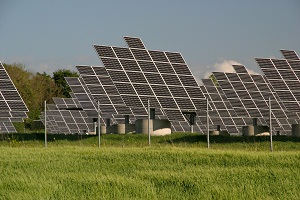U.S. investment in Germany coming back through the sun
 United States’ investment in Germany after World War II helped to develop it into the solar mecca it is today. And now some of that investment is coming back, said Nolan Browne, managing director for the Fraunhofer Center for Sustainable Energy Systems.
United States’ investment in Germany after World War II helped to develop it into the solar mecca it is today. And now some of that investment is coming back, said Nolan Browne, managing director for the Fraunhofer Center for Sustainable Energy Systems.
Browne spoke on a panel of national laboratory directors at the Global New Energy Summit in Colorado Springs last week.
Germany, a country with the same sun resources as the state of Alaska, leads the world in solar development with more than half of all installations and arrays globally. The country is known for its aggressive solar incentives and subsidies, including a feed-in-tariff program.
It’s all the fruits of a lot of labor over a long period of time, Browne said.
The Fraunhofer Institute was established in 1947 as part of the Marshall Plan enacted after the war.
“It really grew up out of the concept of rebuilding Germany,” Browne said. “There was a lot of support from the U.S.”
The Fraunhofer is part of a system of science and research for Germany’s national laboratories. That system separates labs in stages of development with one lab relying almost entirely on public funding to do early-stage basic research, another that gets a mix of funding and the Fraunhofer Center for Sustainable Energy Systems that actually generates most of its revenue commercially, Browne said.
It’s a model system that has worked to bring Germany to the cutting edge, Browne said.
He quoted a friend who once said: “Basic research is taking money and turning it into knowledge, and applied research is taking knowledge and turning it into money.”
“I think it’s really important that you have a set of researchers who stay on that basic research and don’t feel pressure to make money,” Browne said.
That separation, he argues, has helped to develop a tremendous economy around the solar industry in Germany.
Now that the institute has opened labs and offices in the U.S., Browne said there will be some new challenges.
“How do we bring this model to the U.S.?” he asked. “How do you integrate it with the systems and existing infrastructure here?”
Something else Browne said the rest of the world might want to borrow from Germany in developing a solar industry is the creation of a hub.
Freiburg, Germany, is a relatively small community with a university at its heart. As the solar industry developed, businesses gravitated to Freiburg.
Now more than 25 percent of the community’s population works directly with solar photovoltaics, Browne said.
“Freiburg is the center of Germany’s solar world,” he said. “So, the question is, do we need a hub?”
Pictured: Solar arrays outside of Freiburg, courtesy of coronatech.net.



